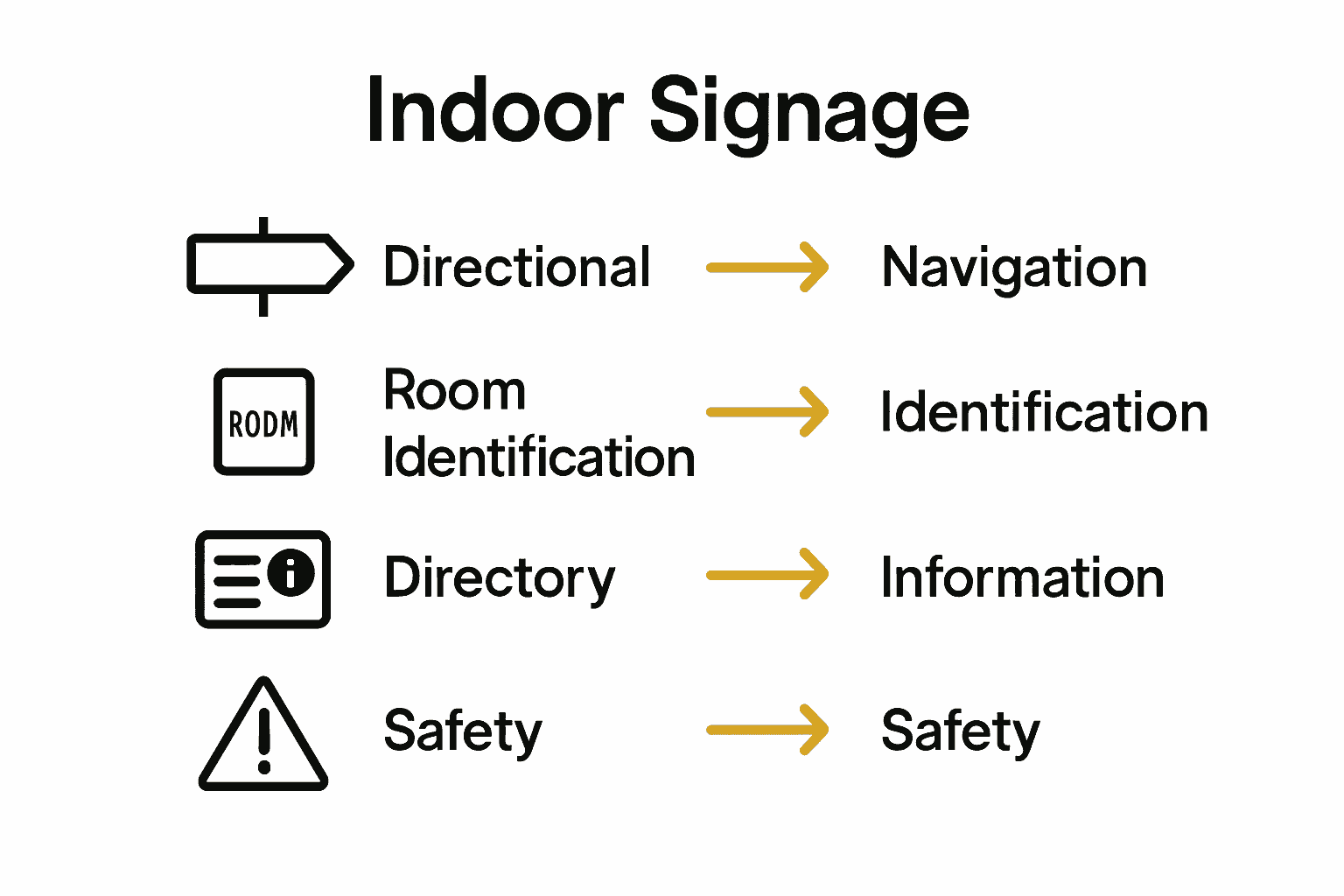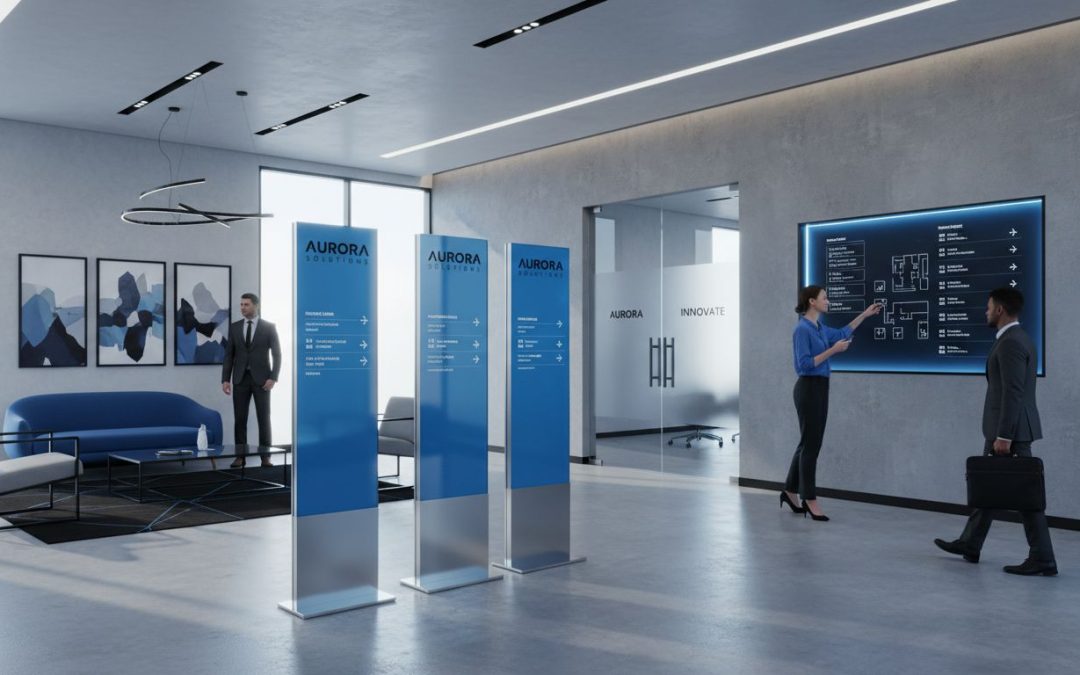{
“@type”: “Article”,
“author”: {
“url”: “https://customsignstoday.us”,
“name”: “Customsignstoday”,
“@type”: “Organization”
},
“@context”: “https://schema.org”,
“headline”: “What Is Indoor Signage? Complete Guide for Businesses”,
“publisher”: {
“url”: “https://customsignstoday.us”,
“name”: “Customsignstoday”,
“@type”: “Organization”
},
“inLanguage”: “en”,
“articleBody”: “Indoor signage explained: Discover types, key functions, real-world applications, costs, and must-know factors in this authoritative guide for businesses.”,
“description”: “Indoor signage explained: Discover types, key functions, real-world applications, costs, and must-know factors in this authoritative guide for businesses.”,
“datePublished”: “2025-11-05T02:43:42.713Z”
}
Over 80 percent of businesses rely on indoor signage to guide people and share important information. Clear signs do more than point the way, they help visitors feel confident and create a lasting impression. Whether you run a busy office, a hospital, or a retail store, understanding the many uses of indoor signage can help you make your space safer, more welcoming, and true to your brand.
Table of Contents
- Defining Indoor Signage And Its Purpose
- Main Types Of Indoor Signage Solutions
- Key Functions And Uses In Business Settings
- Design, Materials, And Installation Essentials
- Costs, Common Pitfalls, And Best Practices
Key Takeaways
| Point | Details |
|---|---|
| Purpose of Indoor Signage | Indoor signage facilitates wayfinding, identification, safety communication, and regulatory compliance in business environments. |
| Types of Signage | Various types of indoor signage, such as directional signs and safety signs, are essential for effective communication with audiences. |
| Design Considerations | Effective indoor signage requires careful attention to design elements, including color, typography, and compliance with regulations for accessibility. |
| Cost and Strategy | Businesses should balance cost, design effectiveness, and user experience to avoid pitfalls and implement best practices in signage strategies. |
Defining Indoor Signage and Its Purpose
Indoor signage represents visual communication tools strategically designed to inform, direct, and engage people within interior spaces. According to boisestate.edu, these are objects specifically created to be viewed in public areas or facilities, communicating critical information through letters, symbols, numbers, and graphics.
At its core, indoor signage serves multiple essential functions for businesses and organizations. Wikipedia explains that signage fundamentally assists people with decision-making by providing clear, actionable information. These visual communication tools accomplish this through several key purposes:
- Wayfinding: Helping people navigate complex interior environments
- Identification: Marking specific areas, rooms, or departments
- Safety Communication: Displaying critical safety instructions and emergency guidelines
- Regulatory Compliance: Indicating rules, restrictions, and organizational policies
Beyond practical communication, indoor signage plays a sophisticated role in brand representation. Well-designed signs transform blank walls and corridors into strategic communication platforms, reinforcing organizational identity and creating memorable visual experiences for visitors, employees, and customers. By combining functional information with aesthetic design, businesses can transform mundane spaces into engaging, informative environments that seamlessly guide and inform their audience.
When considering indoor signage, businesses should recognize these visual tools as more than simple directional markers. They represent powerful communication assets that enhance spatial understanding, promote safety, and communicate organizational values in a single, compelling visual statement. 7 Essential Indoor Signage Solutions for Business Success provides additional insights into maximizing the potential of these critical communication tools.
Main Types of Indoor Signage Solutions
Indoor signage encompasses a diverse range of communication solutions designed to meet specific organizational needs. Wikipedia highlights several primary categories of indoor signs that businesses and institutions utilize to effectively communicate with their audiences.
Here’s a comparison of the main types of indoor signage and their primary uses:
| Signage Type | Main Purpose | Typical Locations |
|---|---|---|
| Directional Signs | Guide people through spaces | Hallways Lobbies Offices |
| Wayfinding Signage | Help navigation in complexes | Hospitals Airports Campuses |
| Room Identification | Mark specific rooms or areas | Offices Meeting rooms Schools |
| Directory Boards | List locations and info | Building entrances Lobbies |
| Safety & Regulatory | Communicate hazards and compliance | Exits Restrooms Labs |
| Interpretive Signs | Provide context or background | Museums Exhibits Visitor centers |
Informational Signs represent one of the most critical types of indoor signage. These signs provide essential details about a space, including:
- Directional Signs: Guiding people through complex environments
- Wayfinding Signage: Helping visitors navigate buildings and facilities
- Room Identification Signs: Marking specific areas, offices, and departments
- Directory Boards: Listing locations, contact information, and organizational structures
Safety and Regulatory Signs play a crucial role in protecting people and ensuring compliance. These signs communicate critical information about potential hazards, emergency protocols, and organizational rules. From exit signs and fire safety instructions to health guidelines and restricted area warnings, these signs are fundamental to maintaining a secure environment.

Interestingly, Wikipedia also notes a unique category of indoor signage known as interpretive signs. Commonly found in museums, educational centers, and specialized facilities, these signs go beyond basic information. They provide context, historical background, and deeper insights about the space or exhibits, transforming simple spaces into engaging narrative experiences. For businesses looking to create more immersive environments, Understanding Types of Promotional Signage for Businesses can offer additional strategies for leveraging these communicative tools effectively.

Key Functions and Uses in Business Settings
Indoor signage serves as a critical communication tool that goes far beyond simple directional guidance. Wikipedia reveals that in business environments, these visual communication platforms perform multiple sophisticated functions, strategically designed to enhance organizational effectiveness and customer experience.
The primary functions of indoor signage in business settings can be categorized into several key strategic areas:
- Information Dissemination: Providing critical details about services, locations, and organizational structures
- Customer Navigation: Helping visitors efficiently move through complex spaces
- Branding Communication: Reinforcing organizational identity and visual messaging
- Operational Guidance: Supporting internal workflows and employee orientation
Wayfinding signage plays a particularly crucial role in business environments. Wikipedia explains that these signs are instrumental in helping individuals orient themselves, significantly improving customer experience and operational efficiency by reducing confusion and enhancing accessibility. When implemented effectively, wayfinding solutions can transform potentially frustrating navigation experiences into smooth, intuitive journeys.
Beyond practical navigation, indoor signage represents a powerful communication medium that bridges informational gaps and creates meaningful interactions within business spaces. By thoughtfully designing signs that are both functional and visually engaging, organizations can create environments that not only guide but also inspire and connect with their audiences. 7 Essential Examples of Indoor Signs for Business Success offers deeper insights into maximizing the strategic potential of these versatile communication tools.
Design, Materials, and Installation Essentials
Creating effective indoor signage requires a strategic approach that balances aesthetic appeal with functional communication. Wikipedia highlights that successful signage design involves critical considerations of visibility, legibility, and precise placement, transforming simple visual elements into powerful communication tools.
Key design elements for impactful indoor signage include:
- Color Selection: Choosing colors that align with brand identity and ensure readability
- Typography: Selecting fonts that are clear and easy to comprehend from various distances
- Size and Proportion: Ensuring signs are proportionate to their environment and viewing distances
- Visual Hierarchy: Organizing information to guide viewers’ attention effectively
Boise State University emphasizes the critical importance of compliance, particularly in material selection and installation. Their standards underscore the necessity of incorporating elements like Braille, appropriate pictograms, and adhering to ADA requirements to ensure accessibility and inclusivity.
Materials play a crucial role in both the durability and aesthetic of indoor signage. From traditional options like wood and metal to modern digital displays, businesses must consider factors such as environment, maintenance requirements, and long-term visual impact. For businesses seeking to elevate their visual communication strategy, How to Design Custom Signs for Impactful Visual Branding provides additional insights into creating signs that not only inform but also inspire and engage.
Costs, Common Pitfalls, and Best Practices
Navigating the complex landscape of indoor signage requires careful consideration of multiple strategic factors. Wikipedia reveals that businesses must balance cost considerations with design effectiveness and regulatory compliance to create truly impactful visual communication solutions.
Cost Considerations for indoor signage can vary dramatically based on several key factors:
- Material Selection: Ranging from budget-friendly options to premium materials
- Design Complexity: Simple designs versus intricate custom graphics
- Size and Scale: Small office signs versus large corporate installations
- Technology Integration: Traditional signage versus digital display solutions
Wikipedia highlights critical common pitfalls that businesses must avoid in their signage strategies. These include creating confusing layouts, implementing inconsistent messaging, and failing to consider user experience. Successful wayfinding depends on clear, strategic communication that helps users navigate spaces intuitively and without frustration.
To mitigate potential challenges, businesses should embrace best practices that prioritize clarity, consistency, and user-centered design. This means developing signage systems that not only look professional but also provide genuine value to users. Interior Signage Explained: Types, Uses, and Compliance offers additional insights for organizations looking to refine their approach to indoor visual communication.
Elevate Your Business with Custom Indoor Signage Solutions
Navigating the complexities of indoor signage can be challenging. You need signs that not only guide customers clearly but also enforce safety and reinforce your brand identity. At https://customsignstoday.us, we understand the importance of combining
wayfinding, room identification, and regulatory compliance with eye-catching design tailored specifically for your business environment. Our custom-made visual communication solutions address these exact needs, helping you avoid confusion and create a seamless visitor experience.

Transform your indoor spaces into powerful communication hubs now. Discover a wide range of high-quality, durable signs crafted just for you at Uncategorized –. Don’t wait to make your space more intuitive and brand-forward — visit Custom Signs Today to request your free quote and start shaping the perfect signage strategy for your business today.
Frequently Asked Questions
What is indoor signage?
Indoor signage refers to visual communication tools designed to inform, direct, and engage people within interior spaces by providing actionable information through letters, symbols, numbers, and graphics.
What are the main types of indoor signage solutions?
The main types of indoor signage include directional signs, wayfinding signage, room identification signs, directory boards, safety and regulatory signs, and interpretive signs, each serving specific communication purposes within businesses and organizations.
How does indoor signage benefit businesses?
Indoor signage enhances organizational effectiveness by improving information dissemination, aiding customer navigation, reinforcing brand identity, and providing operational guidance, ultimately leading to a better customer experience and optimized workflow.
What design elements should be considered for effective indoor signage?
Key design elements include color selection, typography, size and proportion, and visual hierarchy. These aspects ensure the signage is aesthetically appealing and effectively communicates information to viewers.
Recommended
- Interior Signage Explained: Types, Uses, and Compliance –
- 7 Essential Examples of Indoor Signs for Business Success –
- Blog –
- Complete Guide to Outdoor Signs for Businesses –
- What Is Signage Printing? Complete Guide for Businesses – www.printcafeusa.com
- Understanding Digital Signage for Offices: Key Insights – Projector Display

